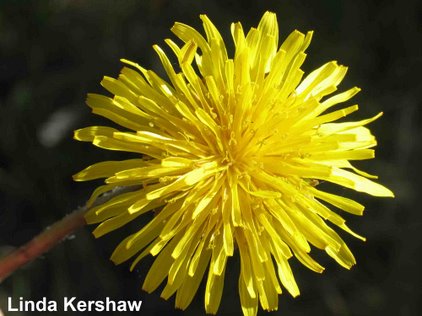Information for Observers
Information on the program is available to interested participants from the author (Alberta Plantwatch coordinator) or at www.plantwatch.ca. Observers select one or more plants to observe, record the calendar dates when the plant blooms, and report these calendar dates either on paper forms or electronically on this website. Observers are told: “When choosing plants for observation, please keep in mind the following. You do not need to report on all species, just the plants near your home or those that are easy to visit regularly. Even one bloom date from one plant is useful. It is best to observe wild plants well away from buildings (heat sources), and in a flat area. If possible, choose plants to observe which reflect about the average for your area (ie: not the earliest or latest to flower). Please observe the same individual shrubs or patch of plants from year to year.”
Growth stages (phenophases)
To ensure quality data, comparable on a wide geographic basis, the following phenophases were updated in 2002 based on protocols developed in Europe.
First bloom: “first flowers open in 3 places” on woody plants, or “first flowers now open’ in a patch of herbaceous plants. (For 1987 to 2001 this had been defined as “10% of buds open”.)
Mid bloom: about 50% of the flower buds are open
Leafing: for 3 woody species; poplar, larch and lilac, observers note the dates when first leaves appear. This day is when the “first leaf is unfurled in 3 different places on the plant”
(NOTE: the stage called Full bloom, or 90% of flower buds open, was also reported for 1987 to 2001.)
Plant Species selected for observation
Since 2002, each province and territory in Canada has run a Plantwatch program. Each chose plant species suitable to their region. Plants were selected that were widespread and easy for the public to identify, bloomed quickly, had flowers sometime in the period from snow-melt to mid summer, and the various species covered a range of habitats. Tips on how to identify (most of) the Alberta plants and to recognize first bloom and mid bloom are at http://www.naturewatch.ca/english/plantwatch/learn_plants.asp?Province=ab
The Alberta Plantwatch species are listed below. All species are native, which means that they occurred in North America long before European settlement, except the introduced species marked with an asterisk (*). Species in bold are also observed in other provinces and territories.
Aspen poplar (Populus tremuloides) Choke Cherry (Prunus virginiana)
Prairie crocus (Anemone patens) Wolf Willow (Elaeagnus commutata)
Bearberry (Arctostaphylos uva-ursi) Common Purple Lilac* (Syringa vulgaris)
Tamarack (Larix laricina) Bunchberry (Cornus canadensis)
Dandelion* (Taraxacum officinale) Northern Bedstraw (Galium boreale)
Early Blue Violet (Viola adunca) Twinflower (Linnaea borealis)
Lodgepole Pine (Pinus contorta) Labrador Tea (Rhododendron groenlandicum)
Golden Bean (Thermopsis rhombifolia) Common Yarrow (Achillea millefolium)
Wild Strawberry (Fragaria virginiana/vesca) Purple saxifrage (Saxifraga oppositifolia)
Saskatoon (Amelanchier alnifolia) White Dryad (Dryas integrifolia/octopetala)
Star-flowered Solomon’s Seal (Smilacina stellatum)
